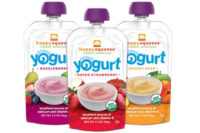IML Arriving

IML containers are quite common in Europe. The dairy case in a typical EU grocery store will have a variety of products that are in thin IML decorated containers. Plastic molders in Europe have been typically molding containers in lower numbers than domestic markets require. Recently however, U.S. plastic molders are taking the plunge, starting to manufacture IML containers and lids in the higher cavity molds required for the U.S. container market.

- Superior Graphics are achieved using IML decoration. Photographic quality graphics can be achieved when Offset Lithography is used to manufacture the labels. This gives a premium look and feel to IML containers and packages.
- The IML process eliminates secondary decorating process. The container ejects from the mold completely decorated. This eliminates post molding print processes, pressure sensitive label application or heat transfer labeling.
- Odd shapes are possible. Square, sqround, wedges, pyramids and other unusual containers can be fully decorated. A square container on a retail shelf provides better utilization of the shelf compared to a cylindrical container. A cylindrical container wastes 45% of the shelf space.
- IML containers can be fully wrapped with a label, thus providing a no-label look. This continuous decoration allows every available square inch of container to be decorated.
- Container handling is minimized, thus reducing work in process. Since the containers are ejected from the mold fully decorated, there is no need for handling or storing the containers prior to the secondary decoration processes. A natural benefit of eliminating handling is cleanliness. The containers have reduced exposure to dirt, dust and other contaminants.
- These containers are fully recyclable. A polypropylene container with a polypropylene IML label can be completely recycled in most domestic municipalities.
- IML is a permanent, tamper proof decoration method. Labels are permanently fused onto the container and cannot be removed without destroying the molded container or lid.
Partnering with an experienced IML container molder will ensure that the five elements of successful IML containers are achieved. A successful IML project begins with properly designing the container or lid for the IML process. There are certain subtle design characteristics that will control the flow of the molten plastic to ensure that the plastic stays behind the label and does not flow over the label. If the plastic flows over the label this of course will bury the label behind the plastic and create a bad container - scrap. The correct container design translates quickly into the mold design - the second element of success. The mold has to be designed with proper clearances for the label automation equipment, part retrieval equipment as well as the critical cooling lines to protect the labels while in the mold.
The mold fits into the third and fourth IML element, the mold machine and the label insertion automation. The molding machine and the label automation work in close synchronization and are closely integrated via modern electronics and sensors. Below is a simplified sequence of how the process works:
- The IML robot retrieves, forms and stages the labels while the mold is closed.
- When mold opens, the decorated parts are retrieved.
- While the mold is open the IML robot quickly inserts a label into each cavity of the mold.

If you have a container or project that you feel might be a candidate for the IML process what should you do? A good starting point would be to ask your current container vendors where they are at with the IML decoration process. Many domestic molders are involved in the process. Some are beginning and others are farther along, however most are aware of IML and eager to learn and get involved. Each project needs to be explored fully to determine its IML economic viability. For an IML container to be economically feasible it will take the right combination of annual quantity, label size, type and size of container,
and marketing desires. In-mold labeling may seem like an impossible endeavor, but for those dairy brands that have the foresight to get involved now it will be a very worthwhile investment because of the advantages gained over today's current packaging.
Sidebar: IML Technology Update Printing Methods
Offset Lithography - Sheet fed printing yields some of the highest possible quality reproduction. Prints with aluminum plates. A variety of inks and coatings are available.Rotogravure - Material printed off of a roll. Excellent for high volume stable graphics. Prints with engraved cylinders.
Flexography - Material printed off of a roll. Graphics are improving. Prints with a soft photopolymer plate.
Screen Printing - Sheet fed printing with the most durable, light fast printing available. Prints method uses ink squeezed through holes in a fine mesh screen using a squeegee.
Digital Printing - Material printed off rolls or sheets. Great for multiple sku's and prototyping. Minimal preparation and pre-press expense. Somewhat limited in IML materials available.
IML Supply Contacts:
Airlite Plasticswww.airliteplastics.com
800/228-9545
American Fuji Seal
www.afseal.com
502/348-9211
Berry Plastics
www.berryplastics.com
812/424-2904
H.S. Crocker
www.hscrocker.com
847/669-3600
Huhtamaki
www.huhtamaki.com
913/583-3025
Idesign
www.imlbyidesign.com
330/722-8774
Smyth Companies
www.smythco.com
800/642-4544
sclysdale@smythco.com
Looking for a reprint of this article?
From high-res PDFs to custom plaques, order your copy today!



